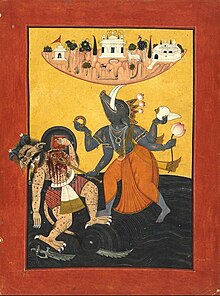Hiranyaksha

Hiranyaksha ( Sanskrit : हिरण्याक्ष = "the gold-eyed") is a demon ( asura ) of Indian mythology. He was killed by Vishnu in the form of a boar ( varaha ) ; this legend is still extremely popular in India today.
Legend
Hiranyaksha and his older brother Hiranyakashipu were originally door guards ( dvarapalas ) in Vishnu's heavenly palace ( vaikuntha ) ; but since they were absent from many sages and ascetics ( rishis and sadhus ) , they were cursed by them and condemned to be reborn as sons of Diti and Kashyapa , the parents of many demons. Hiranyaksha received from Brahma the gift of invulnerability through all beings whose names he could name, which subsequently led him to terrorize mortal men and immortal gods alike. He even stole the Vedas and abducted the earth in the form of the earth goddess Bhudevi into the depths of the ocean.
Hiranyaksha had forgotten the boar when he enumerated it, whereupon Vishnu assumed the shape of a huge black boar (varaha) - big as a mountain, as powerful as a lion - whose roar sounded like the rumble of thunder and whose eyes sparkled like lightning. He went into the depths of the sea, tracked down Hiranyaksha and killed him. He brought the earth goddess and the Vedas back to the surface.
According to another version of the legend, while Brahma was busy creating the world, the earth (Bhu , Bhumi , Prithivi) fell to the bottom of the primeval ocean. The demon (asura) Hiranyaksha had meanwhile requested land from the water god Varuna in vain. From the sage Narada he learned that varaha had dived into the ocean and pursued him. In a fierce battle, Hiranyaksha was killed and the gods worshiped Vishnu as their supreme god.
presentation
The legend is often reduced to the representation of Vishnu (varaha) and Bhudevi - Hiranyaksha cannot be seen. In medieval Indian sculpture he is often shown, just before his annihilation, begging Vishnu for mercy; in other portraits he lies on the ground and Vishnu stands on him. In the miniature paintings of later centuries he is depicted - sometimes beheaded, sometimes as a tailed devil.
symbolism
Demons (cf. also Andhaka , Hiranyakashipu , Mahisasur ) endanger the existing order - wanted by gods and humans. They unite in themselves all evil, d. H. destructive, selfish and ultimately stupid forces. They remove people from a peaceful coexistence in which values such as wisdom and inner balance and harmony, but also peace, security and order play a dominant role.
literature
- Anneliese and Peter Keilhauer: The Imagery of Hinduism. The Indian world of gods and their symbolism. DuMont, Cologne 1986, p. 82ff, ISBN 3-7701-1347-0 .
- Veronica Ions: Indian Mythology. Hamlyn Publishing, London 1988, p. 49, ISBN 0-600-34285-9 .
Web links
- Hiranyaksha - Legend (Engl.)
Individual evidence
- ↑ Veronica Ions: Indian Mythology. Hamlyn Publishing, London 1988, p. 49, ISBN 0-600-34285-9 .
- ↑ Anneliese and Peter Keilhauer: The visual language of Hinduism. The Indian world of gods and their symbolism. DuMont, Cologne 1986, p. 82ff, ISBN 3-7701-1347-0 .
